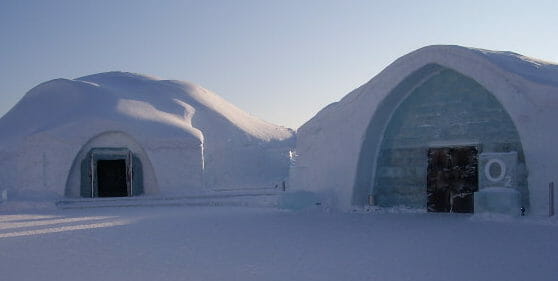Cooling a Warmer World Heats It Even More
Air conditioning is already a political hot potato. Refrigeration could soon be a burning issue. Cooling a warmer world will cost the earth in climate terms. Ice hotel at Kiruna, Sweden: Keeping cool is not always so easy. (Hucul at Czech Wikipedia / Wikimedia Commons)
Ice hotel at Kiruna, Sweden: Keeping cool is not always so easy. (Hucul at Czech Wikipedia / Wikimedia Commons)
In the next three decades cooling a warmer world will bring soaring demand for equipment to bring the mercury down. The appetite for energy to fuel air-conditioning, cold stores, refrigerated transport and medical “cold chains” that preserve vital vaccines could rise nearly five-fold.
So, paradoxically, humans will raise the planetary average temperatures even higher in the effort to keep cool. A new study calculates that, between now and 2050, an estimated 19 cooling appliances will be sold every second, and to meet global demand three decades on the number of cooling appliances in use worldwide must reach 14 billion.
And even then, many lives will be exposed to dangerous levels of temperature and humidity during extreme summer heat.
But the hazard of climate change driven by global warming, itself fuelled by human use of fossil fuels to deliver the energy both to power economies and to cool the great cities, is not the only force that will bring ever greater investment in cool technologies.
The other great driver for change, say scientists at the University of Birmingham in the UK, in their report A Cool World, is the need to meet the UN development goals to reduce economic inequality, extend and enhance the lives of the poorest, make food supplies safe, reduce ruinous waste and find new ways to deliver health to the poorest communities far from the great cities.
The chilling reality is that the investment in energy to cool things down could make the world even more dangerously hot. To meet the global action target agreed by 195 nations in Paris in 2015 and contain global warming to no more than 2°C above the average through most of human history, total energy consumption for cooling must be kept to 6,300 terawatt hours a year.
Right now, cooling demands 3,600 terawatt hours a year. But all the signs are, say the Birmingham scientists, that by 2050 demand could require 19,600 terawatt hours a year.
So, they say, to meet climate goals and push through the UN development agenda, nations need to think again: they need to devise more efficient methodologies, and less costly cooling strategies.
The problem is enormous, and for some people 30 years from now will become a matter of life and death. Researchers have already established that potentially lethal levels of heat and humidity are on the way for some regions, and many of the world’s crowded megacities in particular could become dangerous places for the poorest.
Direct feedback
There are rewards – even in climate terms – for investing in efficient cooling: it could cut food waste, save lives and effort, and contain further warming.
But the air conditioning that could made life tolerable in overcrowded, airless cities could also directly feed back into further global warming, according to other studies.
Some of the extra energy demand could be met from renewable energy sources – solar and wind power, for instance – that do not spill dangerous levels of greenhouse gases into the atmosphere.
But to “green” the world’s air conditioning by 2050 would consume 80% of all the wind and solar energy so far expected on stream three decades from now, and if the technology of cooling is not made more efficient, it could take up more than 100%.
Joined-up thinking
So the case for a concerted strategy is made clear in the Birmingham report. It calls for better building design, more efficient ways of doing things, strategic thinking across whole sectors and faster elimination of waste.
“The challenge now is how to start with a system-led approach, better harnessing a portfolio of energy resources and adopting novel technologies,” said Toby Peters, of the University of Birmingham’s energy institute, and one of the authors.
“In order to achieve this we need to start asking ourselves a new question – no longer ‘how much electricity do we need to generate?’ but rather ‘what is the service we require, and how can we provide it in the least damaging way?’”
And in the same week a second study highlighted, in a small way, the case for equal opportunity in an air-conditioned world. Students who live in air-conditioned dormitories in the US will, during a heat wave, do better in tests demanding concentration and cognitive skill than those left to sweat things out at night.
Risk to young
That is: although extremes of heat represent a serious danger to the oldest, the already ill and the poorest, they make a distinct difference even to the young, the healthy and the privileged, according to a new study in the Public Library of Science journal PLOS Medicine.
US scientists report that they proved their point with tests, in the summer of 2016, in a period marked by a five-day heat wave, on 44 students, 24 housed in modern buildings with air conditioning, 20 in much older buildings with no such temperature controls. The students who kept cool at night were not just faster in their responses to tests, but more accurate.
“Most of the research on the health effects of heat has been done on vulnerable populations, such as the elderly, creating the impression that the general population is not at risk from heat waves,” said Jose Guillermo Cedeño-Laurent, of Harvard University medical school, in Massachusetts, who led the study.
“To address this blind spot, we studied healthy students living in dorms as a natural intervention during a heat wave in Boston. Knowing what the risks are across different populations is critical considering that in many cities, such as Boston, the number of heat waves is projected to increase due to climate change.”
Your support is crucial…With an uncertain future and a new administration casting doubt on press freedoms, the danger is clear: The truth is at risk.
Now is the time to give. Your tax-deductible support allows us to dig deeper, delivering fearless investigative reporting and analysis that exposes what’s really happening — without compromise.
Stand with our courageous journalists. Donate today to protect a free press, uphold democracy and unearth untold stories.






You need to be a supporter to comment.
There are currently no responses to this article.
Be the first to respond.